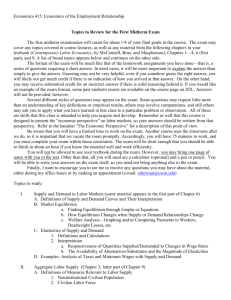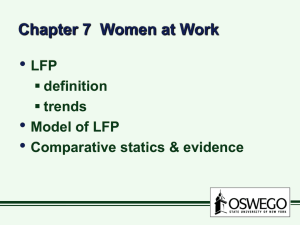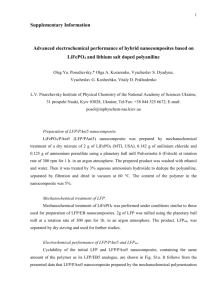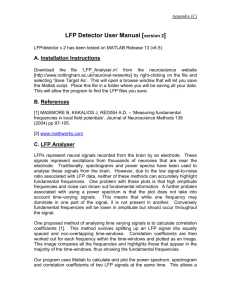Chapter 3 Labor Force Participation
advertisement
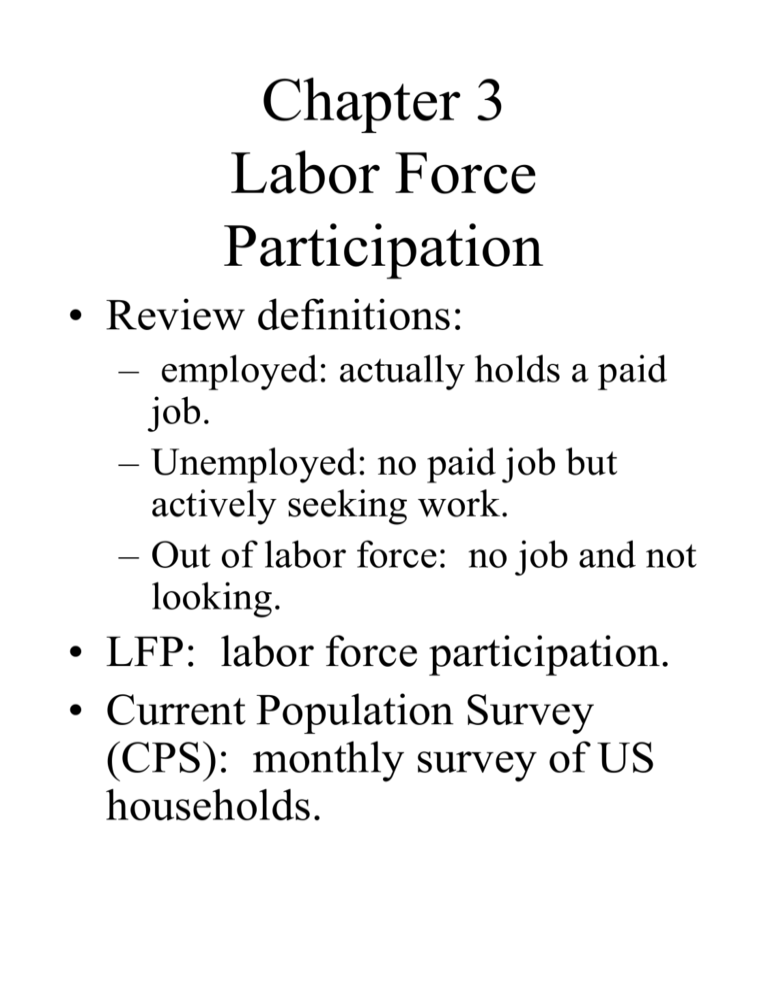
Chapter 3 Labor Force Participation • Review definitions: – employed: actually holds a paid job. – Unemployed: no paid job but actively seeking work. – Out of labor force: no job and not looking. • LFP: labor force participation. • Current Population Survey (CPS): monthly survey of US households. Figure 3.1 • Shows LFP trend from 1950 to 1998 for entire population, then broken down by sex. • Overall: • Men: • Women: Modeling the Decision to Work • Corner Solution: In some circumstances, with a given market wage, nonlabor income, and set of preferences, the utility-max hours choice will be zero hours. • At this corner solution: • MRS wage. Reservation Wage • Reservation wage = WR = the wage at which the individual is indifferent between working and not working. • Measure WR : • LFP rule: mkt W WR Effect of Wage on LFP • Start out of LF: WM WR. • As WM it approaches WR until it reaches WR, at which time the person is indifferent between working and not working. • So: WM probability of being in the LF. • Note: this WM causes a pure substitution effect so result is clear (no income effect). More on W and LFP • * LFP more responsive to W than hours worked because LFP responds with pure substitution effect causing probability of LFP, while hours worked has both effects. – LFP wage elasticity is greater than hours elasticity. • * Estimated LFP elasticities always positive, even for men. • If start in LF: a W could cause person to stop working. Effect of Y on LFP • As income es, the point on the indifference curve where the optimal point occurs es too, so the MRS is ing. This means even with no W, the MRS can so that the comparison between W and MRS can result in a in LF state. • The Y causes the optimal point to move up to a steeper portion of the indifference curve where MRS is bigger. • Show on graph by tracking MRS at different income levels. Deficiencies in Formal Labor/Leisure Model • 1. Ignores family context • 2. Ignores unpaid work or nonmarket home time. • Two trends have importance of these deficiencies: • 1. female LFP (even married) • 2. men’s involvement in home work activities. • See the Family Model. Family or Household Model • Key extension: each potential worker has 3 uses of time: – market work – home work – leisure • Decision-making unit is the family. • Effect of Y on family’s time allocation: – Demand for leisure, so hours in other two categories. Effect of Wage on Labor Supply • Assume husband and wife: person 1 and person 2. • If W of person 1: income and substitution effects for this person, plus cross-income and cross-substitution effects for spouse very complicated! • * • Key is relationship between husband and wife’s time: Empirical Evidence • What do empirical studies tell us about whether spouses’ time are substitutes or complements (I.e., what is sign of the crosseffects): Key is presence of children in the household. – No kids: – Yes young kids: Relate Back to LFP Trends • Remember: over time, male LFP while female LFP: • LFP rule: choose to participate in LF if Wmkt WR • Verbally: each spouse works an extra hour for pay if Wmkt than time in leisure OR home work. • Men: • * • * • * Continue • Women: relatively low wages; few substitutes for home-produced goods like meals, cleaning, and childcare. • Key Point: With a W, men mostly moving between paid work and leisure, while women are moving between paid work, leisure, and home work. • So women have bigger substitution effect explains why substitution effect more likely to dominate for women. Becker’s Time Allocation Model • Key: Final consumption goods are what give individuals utility; These final consumption goods can be produced with some combination of paid goods and home-produced goods. • Time is an input in this process of producing final consumption goods. • Final consumption goods include true leisure activities that generate utility. • So: W substitute AWAY from both home-production and time-intensive leisure time. More Detail on Male LFP • Review male LFP trend: • At same time: real wages grew about 45% Y effect has dominated substitution effect. • See Figure 3.5: Ageparticipation profiles: Decompose the Male LFP into different age groups • This decline seen mostly in: – 1) young men (ages 16-24) – 2) prime-aged men (ages 45-64) – 3) men at retirement age (age 65+). • Four factors: – – – – 1)Life-cycle allocation of time 2) Social Security/Private pension plans 3) Growth in disability benefits 4) Decreased demand for low-skilled workers. • Some factors specific to a single age-range; some are broader. Life-Cycle Allocation of Time • More complex model required: when I decide hours worked today, I care about hours I hope to work in the future as well. • Key is time trend in wages: – For an individual across a lifetime • Rewards to work greatest at midlife – Shifting average profile over time • Economic growth causes wages over time for all ages (shift in entire age-wage profiles) Life-Cycle Effect Broken Down by Age • For Ages 65+: At some age, real wages actually • For young men: reallocation of time from work to school because bulk of job growth in high-skill jobs (called investment in human capital) • Why done early in life? – Wage lower – HK investment has more years to get payoff.in higher wage. Effect of Social Security and Private Pensions • Trend: coverage and benefits for both plans. • Effect of SS: • SS changing over time: age is • Private Pensions: Two types: – Defined Benefit: – Defined Contribution: Decline LFP of PrimeAged Men • Two reasons: – 1) growth in disability benefits – 2) demand for low-skilled jobs • Disability Benefits: Part of SocSec: SSDI; Big # recipients and monthly benefit. • Demand for low-skilled jobs: hits older workers worse since no time for substantial HK investment. Lost Y from not working has fallen. • Differences by race: – African-Americans hit harder by disability and disproportionately represented in low-skill jobs. Female LFP Rates • Remember the big increase over time in female LFP rate: • Percentage of total US labor force that is female: – * – * – * • Today, more than 50% of mothers with preschool children are in paid LF To Note in Figure 3.7 • Age-LF Participation profiles for women in 3 years: • Two major features: – 1) female LFP for all age groups up to 65 – 2) ing LFP pattern for women in childbearing years. • Currently:: still bit of peak at age 24, but then stays fairly high. 6 Reasons for Female LFP • 1. Rising real wages. • 2. es in fertility patterns. • 3. es in educational attainment. • 4. ing living standards. • 5. job opportunities. • 6. ing social attitudes. Details for the 6 Reasons • Reason #1: real wages: for females, substitution effect is dominant, causing LFP. • Reason #2: Fact: having young children increases value of nonmarket time. • What has ed? • (i) #kids per mother has declined. Why? Continue with #2: • (ii) postponement of childbirth for many women: • * • * • Key: hard to establish career while also having young children. So some have kids later; some have no kids at all. – 1992 survey of female executives: 42% had no kids continue • Third component of changing fertility patterns: • More women continue to work even when children are young • * • * • One result: dramatic increase in utilization of non-maternal child care Education Changes • This is reason #3: • Changes in Educ. Attainment: Big increase in women getting 4-year college degree. • Anyone with college degree: more likely to be in paid LF; why? –* –* –* Continue • High divorce rates tend to education as means to economic independence. • Also: es in Field of Study: • * • * • * Reason #4: Living Standards • Theory: female LFP so that family can maintain a good standard of living, even though: – Male wage growth for collegeeducated workers declined in 70s and 80s; – For unskilled workers, real wages actually fell. Reason #5: Increased Job Opportunities • In past 50 years, “female” jobs have experienced aboveaverage job growth. • In 1997, over half of working women in 6 occupations: – – – – – – Administrative support Food preparation services Sales clerks in retail trade Teachers Secretaries and typists Nurses More on Reasons • Also:some females moving into previously maledominated occupations. • * • * • Reason #6: Changing social attitudes: – If wife works, no longer conclude that husband is a failure. – More acceptance of child care. All 6 Factors Related • Not possible to know what caused what. • Were the rising real wages most important? • Did more women working cause the shifting in social attitudes? • One way to disentangle different factors is to compare LFP trends across countries. From Figure 3.8 • Four industrialized countries. • Sweden similar to U.S.: big female LFP. • Germany and Japan : some fluctuation but no overall . • Average female real wage grew much in all four countries; suggests other factors have some importance too. Japan and Germany • Japan: decline in agriculture, a “female” occupation. • Germany: LFP patterns differ for different subgroups ( young single women; for married women). • Social attitudes very different: – Japan: explicit discriminatory hiring policies – Germany: unlike U.S., did not use females to combat acute labor shortage in defense industry in WWII Bargaining Model of Female Labor Supply • More institutional version of the HH model. • Key factor: family decisions reflect family’s power structure: if husband earns all money, he has all power. • As better job market opportunities opened up for women and social attitudes changed, their LFP and so power in family shared more equally. LF During Recessions • Issue: During recession, does LF expand or contract? Two forces work in opposite directions. • Added Worker Effect: temporary entrance into LF of “secondary” workers in response to unemployment of primary household worker. (Due to Y effect.) • Discouraged Worker Effect: laid off worker leaves LF. Real LFP decision rule is: compare WR and expected wage, where E(W) is less than actual WM due to low chance of getting job. Dominant effect in recession.

